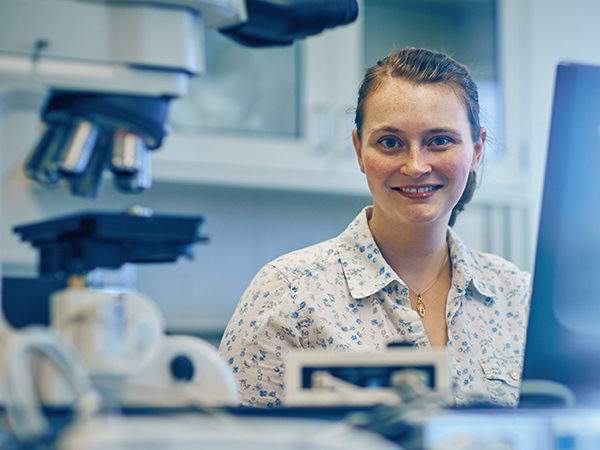Breaking down barriers
Materials scientists have a hand in nearly everything we use, from shatterproof smartphone cases to recyclable plastic bottles to coatings that make skis and snowboards glide through the snow to lifesaving medical devices

Unlike a classic science or engineering field, materials science is an interdisciplinary field that requires expertise in chemistry, physics and biology, allowing engineers to look at a problem from a variety of perspectives. These engineers look at the structure of materials, their properties and performance. They test materials in different ways to see if any of those qualities change under different stressors, such as temperature, pressure and impact.
The School of Engineering & Applied Science and the Graduate School of Arts & Sciences recognized the importance of training these scientists and engineers to meet the increasing demand for advanced materials when it launched a unique Materials Science & Engineering doctoral program within the Institute of Materials Science & Engineering (IMSE) in 2013. Within the program, students are working collaboratively on a range of advanced materials created for the next generation of products that will improve productivity through better and more sustainable semiconductor devices and improve medicine and health care through using nanoparticles to create better biomaterials. The program emphasizes interaction among students and laboratories as well as breaking through departmental barriers by allowing students to rotate through various disciplines to find their niche.
IMSE was born from the Materials Genome Initiative, launched by the White House in 2011 to accelerate materials innovation and development in the United States. Kenneth Kelton, PhD, the Arthur Holly Compton Professor of Arts & Sciences in the Department of Physics, and Katharine Flores, PhD, professor of mechanical engineering & materials science in Engineering, are co-directors of IMSE.
"IMSE would have never started without Ken Kelton," Flores says. "He was the right person to start this institute. He knew all the players and knew what needed to be done and was really sensitive to making sure it was an Arts & Sciences and Engineering collaborative activity. He's done a great job."
Flores says when admitting students, the team is careful to ensure that each student will have a place in a lab that matches their interest area.
"The students who have found their places in groups and students who have come in with materials undergraduate or master's degrees have been placed in chemistry and physics groups or other groups, so we have made that transition and broken down that barrier, which is the most important thing for the interdisciplinarity of the program," Flores says.
 Sirimuvva Tadepalli, a fourth-year IMSE doctoral student, is working on the interface between nanoparticles and proteins in the lab of Srikanth Singamaneni, PhD, associate professor of materials science. Tadepalli says she appreciates the size of the program, which now has 14 students.
Sirimuvva Tadepalli, a fourth-year IMSE doctoral student, is working on the interface between nanoparticles and proteins in the lab of Srikanth Singamaneni, PhD, associate professor of materials science. Tadepalli says she appreciates the size of the program, which now has 14 students.
“Because there are so many resources and not as many students, there is one-on-one interaction,” says Tadepalli, who earned a bachelor’s degree in metallurgy from the National Institute of Technology in Warangal, India. “All of the professors know you, and they are more approachable, giving you a different perspective which is very important for interdisciplinary research.”
 Kelly Kranjc, who is in the final year of the program, is the secretary for the graduate student group ProSPER (Promoting Science Policy, Education, and Research) and has become an advocate for science education through the group Material Advantage, a national organization for students in materials science.
Kelly Kranjc, who is in the final year of the program, is the secretary for the graduate student group ProSPER (Promoting Science Policy, Education, and Research) and has become an advocate for science education through the group Material Advantage, a national organization for students in materials science.
Kranjc has made two visits to Washington, D.C., to meet with Congressional staffers about federal funding for science and engineering. “I feel like that’s something that I can contribute to — trying to get the word out that what we’re doing is important and needs funding and trying to be a liaison between the scientists and Congress,” says Kranjc, who earned a bachelor’s degree in chemical engineering from the University of Dayton.
As an undergraduate, Kranjc was working at the Air Force Research lab in Dayton developing composites for aircraft that would be resistant to lightning strikes. In Flores’ lab, she studies the micromechanical properties of metallic glass.
Kelly Kranjc works in Flores’ lab and came with Flores from the Ohio State University, where Kranjc had already completed two years of study.
 Yvonne Afriyie, a native of Ghana, studied chemistry and math at Newman University in Kansas. Afriyie knew she wanted to continue her education, building on her chemistry background. Now in her second year at WashU, Afriyie took advantage of the program’s rotation offering and is now working in the lab of Sophia Hayes, PhD, professor of chemistry, characterizing semiconductor thin film materials using solid-state nuclear magnetic resonance.
Yvonne Afriyie, a native of Ghana, studied chemistry and math at Newman University in Kansas. Afriyie knew she wanted to continue her education, building on her chemistry background. Now in her second year at WashU, Afriyie took advantage of the program’s rotation offering and is now working in the lab of Sophia Hayes, PhD, professor of chemistry, characterizing semiconductor thin film materials using solid-state nuclear magnetic resonance.
“In IMSE I’ve been exposed to different areas than I would have if I were only in chemistry,” Afriyie says. “I’ve taken classes in engineering, physics and chemistry, which would have otherwise not been needed unless it complemented or enhanced my understanding in my area of specialization. But there are several core requirements in IMSE that broaden our knowledge and show us different ways of thinking about the same thing.”Back to Engineering Momentum
